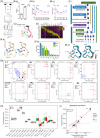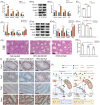Increased oxidized low-density lipoprotein in mice exposed to a high-fat diet impaired spermatogenesis by inhibiting testosterone synthesis via the Klk1bs/Eid3 pathway
- PMID: 38433441
- PMCID: PMC10909978
- DOI: 10.1002/ctm2.1603
Increased oxidized low-density lipoprotein in mice exposed to a high-fat diet impaired spermatogenesis by inhibiting testosterone synthesis via the Klk1bs/Eid3 pathway
Conflict of interest statement
The authors declare no conflict of interest.
Figures




Similar articles
-
Oxidized-LDL inhibits testosterone biosynthesis by affecting mitochondrial function and the p38 MAPK/COX-2 signaling pathway in Leydig cells.Cell Death Dis. 2020 Aug 14;11(8):626. doi: 10.1038/s41419-020-02751-z. Cell Death Dis. 2020. PMID: 32796811 Free PMC article.
-
High fat diet-induced obesity prolongs critical stages of the spermatogenic cycle in a Ldlr-/-.Leiden mouse model.Sci Rep. 2022 Jan 11;12(1):430. doi: 10.1038/s41598-021-04069-y. Sci Rep. 2022. PMID: 35017550 Free PMC article.
-
Overfeeding Saturated Fat Increases LDL (Low-Density Lipoprotein) Aggregation Susceptibility While Overfeeding Unsaturated Fat Decreases Proteoglycan-Binding of Lipoproteins.Arterioscler Thromb Vasc Biol. 2021 Nov;41(11):2823-2836. doi: 10.1161/ATVBAHA.120.315766. Epub 2021 Sep 2. Arterioscler Thromb Vasc Biol. 2021. PMID: 34470478 Free PMC article. Clinical Trial.
-
Characterization of secretory sphingomyelinase activity, lipoprotein sphingolipid content and LDL aggregation in ldlr-/- mice fed on a high-fat diet.Biosci Rep. 2012 Oct;32(5):479-90. doi: 10.1042/BSR20120036. Biosci Rep. 2012. PMID: 22712892 Free PMC article.
-
The role of dietary oxidized cholesterol and oxidized fatty acids in the development of atherosclerosis.Mol Nutr Food Res. 2005 Nov;49(11):1075-82. doi: 10.1002/mnfr.200500063. Mol Nutr Food Res. 2005. PMID: 16270280 Review.
Cited by
-
Sex Differences in Cardiovascular Diseases: Exploring the Role of Microbiota and Immunity.Biomedicines. 2024 Jul 24;12(8):1645. doi: 10.3390/biomedicines12081645. Biomedicines. 2024. PMID: 39200110 Free PMC article. Review.
-
High-fat diet-induced L-saccharopine accumulation inhibits estradiol synthesis and damages oocyte quality by disturbing mitochondrial homeostasis.Gut Microbes. 2024 Jan-Dec;16(1):2412381. doi: 10.1080/19490976.2024.2412381. Epub 2024 Oct 16. Gut Microbes. 2024. PMID: 39410876 Free PMC article.
-
UCHL1 regulates adiponectin receptors in Sertoli cells to maintain testicular homeostatic balance.J Biol Chem. 2025 Jun;301(6):110221. doi: 10.1016/j.jbc.2025.110221. Epub 2025 May 9. J Biol Chem. 2025. PMID: 40349775 Free PMC article.
References
-
- Matsui H, Takahashi T. Mouse testicular Leydig cells express Klk21, a tissue kallikrein that cleaves fibronectin and IGF‐binding protein‐3. Endocrinology. 2001;142:4918‐4929. - PubMed
-
- Matsui H, Moriyama A, Takahashi T. Cloning and characterization of mouse klk27, a novel tissue kallikrein expressed in testicular Leydig cells and exhibiting chymotrypsin‐like specificity. Eur J Biochem. 2000;267:6858‐6865. - PubMed
Publication types
MeSH terms
Substances
Grants and funding
- 32172726/National Natural Science Foundation of China
- 32272872/National Natural Science Foundation of China
- 20210202103NC/Key Research and Development Program of Jilin Province
- 20210202048NC/Key Research and Development Program of Jilin Province
- 20190301008NY/Key Research and Development Program of Jilin Province
LinkOut - more resources
Full Text Sources
